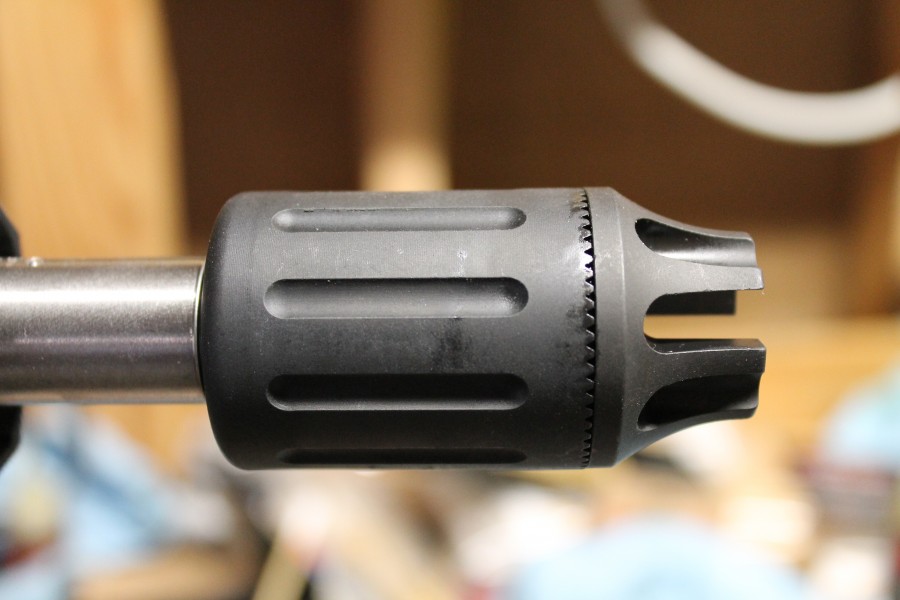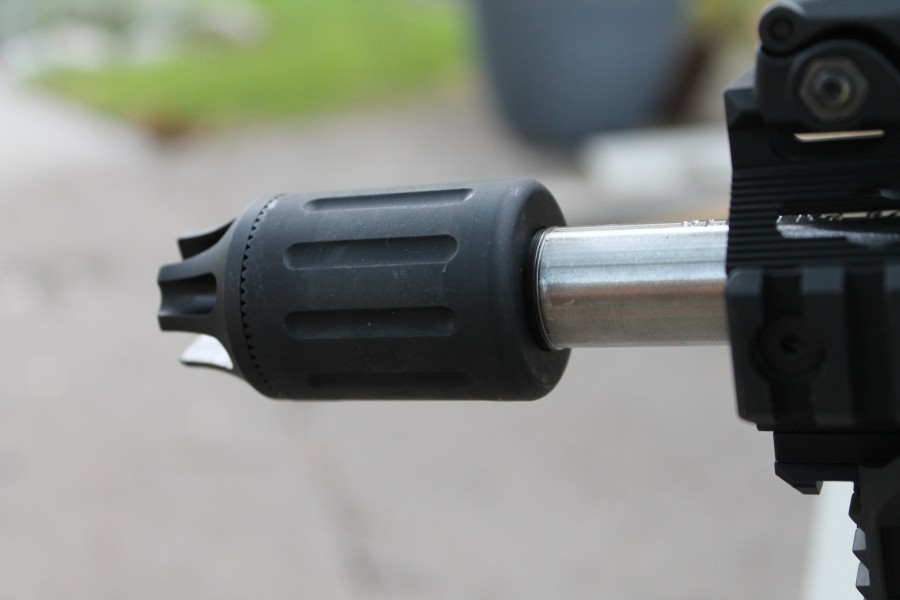One of my notes during my testing of the PWS MK 107 was how loud the muzzle blast was. Specifically, I called it a downright religious experience to spectate while someone shot the MK 107 in and around your area. That blast is unavoidable when running a projectile with that much unburned powder behind it out of such a short barrel. And while the factory-installed Triad muzzle device did an admirable job of dealing with muzzle rise, it didn’t do a thing to baffle the boom. Enter the CQB Muzzle Device . . .
The CQB is a hollow “cup” threaded to the barrel with a threaded end cap on the end of the cup. Reminiscent of a small silencer (it doesn’t), the CQB is designed to redirect the sound towards the front of the gun for operations where others might be off to your side. The logical customer base is law enforcement and military, units who go into buildings as a team, sometimes guns a-blazing. That said, your ordinary consumer can probably realize some benefit, especially those shooting at crowded indoor ranges or competing in 3-gun competitions.
A quick note about my testing protocol. The CQB was designed for short-barreled guns like the MK 107. Unfortunately, I didn’t have the MK 107 when I received the CQB so I mounted it to a 16-inch barreled AR chambered in .223 Wylde. I then had my lovely assistant, my wife, shoot it side by side with a 14.5 inch barreled AR chambered in .223 Wylde. I used the same ammo, PMC Bronze 55 gr., in both guns.
I had my wife shoot while I stood about 15 feet off to the side about even with the muzzle. We then switched roles, and I asked for her opinion on the two. She and I both agreed that the CQB had a VERY different sound profile. Though not exactly quieter, the sound didn’t seem to sharply stab either of us in the ears like the 14.5 Triad equipped upper. The sound is definitely a softer push. While I would still never shoot this gun without hearing protection, it does seem to soften the blow a bit.
A quick note about weight. As you can see above, the CQB weighs in at 7.5 oz. On a 7 to 9 inch barreled gun, this is probably not significant enough to make a huge difference. However, when put on the end of a 16 inch gun, it changes the balance significantly, making it very muzzle heavy. This does help fight muzzle rise, no doubt about it. But for those without superhuman upper body strength, it gets tiring very quickly to push nearly half a pound around the front of a gun. As this was designed for short barreled guns, and I tested it outside of that design scope, I won’t knock points on a review, but it is something to consider if you’ll be building a short barreled gun.

Specifications: PWS Close Quarters Battle Muzzle Device
- Caliber: .223 as tested. .30 available as well.
- Length: 2.57”
- Diameter: 1.4”
- Thread Pitch: 1/2×28 RH
- Weight: advertised – 7.3 oz measured – 7.5 oz
- Price: $149.95 – MSRP $144.95 – online
Ratings (out of five stars):
Build Quality * * * * *
It takes a pretty robust build to contain the escaping gasses of a short barreled rifle, and the PWS CQB seems to be solidly built. The removable end cap stays put thanks to a spring detent, and gives a positive click to indicate that it is in place. The thread pitch mated perfectly, and given the hefty nature of the CQB, I’m confident this is a unit that will last a lifetime.
Installation * * * *
All the necessary hardware to install the CQB is included in the box, but there is a note that you need a strap wrench to install the CQB. They can be found at most home improvement stores for less than $20 if you don’t already own one. If you’re doing an install, you don’t need a vise and action block to mount the CQB, though you should absolutely use one. If you’re removing an existing muzzle device, you absolutely should use the proper tools including an action block and vise.
Sound Modification * * * * *
I was pleasantly surprised at how well the CQB does in modifying the sound profile of the chipper little .223 round. While my wife needed to clamp her hands to her headphones to quell the noise from the “normally” muzzled 14.5″ gun, she found the CQB to be a much nicer experience to stand beside. I also felt that the CQB gave more of a gentle push than a sharp strike to the eardrums.
Overall * * * *
The CQB does a fine job of modifying the sound profile in a manner consistent with PWS’ advertising. It adds a little under half a pound to your build, so tread lightly if you’re worried about total weight or balance. Otherwise, it does an admirable job of channeling the sound forward to save your buddy’s eardrums.








I’ve been looking for a muzzle brake for a ** 9mm pistol build **
Who makes a decent to good 9mm AR muzzle brake?
JP Enterprises offers on on the GMR-13. I’m sure you could order it separate.
I have one on my GMR, but it’s pinned and welded on a 14.5″ barrel so I can’t shoot in without to determine effectiveness. It sure does look nice and matches the brake on my 223 rifle
No real reason I can think of to get a 9mm AR / rifle muzzle brake. Any 9mm pistol muzzle brake / compensator will work on your AR build as long as the threads are correct (usually 1/2×28).
These guys make custom ones: http://www.maddmacsprecisiontactical.com/9mm-compensators.html
Lone Wolf has a ton that would work (ANY on this page threaded 1/2×28, assuming this is what your AR is threaded for… so any of the .357 Sig, 9mm, .40-9 conversion, 9mm Major, etc): https://www.lonewolfdist.com/Products.aspx?CAT=313
Additionally, tons and tons of your standard AR-15 brakes can be bored out to 9mm without issue. Some won’t be able to accommodate the larger hole, but many or even most of them can. Any machine shop or gunsmith w/ a machine shop could bore one out for you, and on many brakes it only requires enlarging a single hole and you could easily do it yourself. I have a couple of favorites so if I wanted one on my 9mm AR I would probably go the route of boring out one of those.
Thanks
Be interesting if they would work on something for big bore bolt guns intended for Africa. If you read about African PHs even minimally you will catch comments and opinions that muzzle brakes are hated on these canons. Some outright ban them. The PHs tell of guides, trackers etc having ears and hearing damaged by them. Remembering that an African native tracker has grown up and lives in an audio pristine environment. Hearing of these folks has not been damaged by the noise of 1st world urban life. This type of device might be looked upon as useful.
why? so that their eyes can be damaged too by flying steel shrapnel from using a muzzle device rated for 223/556 pressure on a rifle with nearly 6 times the case capacity?
These things have a very narrow set of uses. I know that Noveske says their version this is really only useful on barrels less than 12 inches. That’s a lot of weight to stick out on the end of a normal sized gun, and they create an enormous amount of backpressure. Slap one on a 375H&H or similar African gun, even if the hole on the end is made big enough it would be like standing next to an improvised hand grenade. No thanks.
Tex …. pls re-read my first sentence. “they” refers to the company making these devices not the device for .223. I would have said “it ” if I was referencing the device itself.
Yeah that thing you were talking about… they are called suppressor they work really well, doohhh!!!
This device if sized appropriately for a big bore “african gun” would weigh about as much as the rifle weighs. Again, this device and the Noveske KX3 (same idea) have such a narrow range of applications and they are so heavy they really only lend themselves to SBR’s. “African Guns” as you call them are already large, long action and heavy, even in sporter weights, and are usually carried around and shot unsupported or off of a shooting stick at the most, so the weight of this muzzle device is not welcome. Add to that, the fact that on a long barrel these gimmicks are barely, if at all, better than a bare muzzle alone. So yeah I read your post, all of it… the idea you presented is stupid and already done better by a suppressor, sorry my humorous analogy to a mini hand grenade offended you… deal with it.
I don’t understand why they use muzzle brakes on “Africa guns”. Silencers are cheap + uncontrolled there so it isn’t that more expensive to buy one while you are there. When you are done with it it makes a nice gift to your tracker/guide.
This sort of silliness is why we need to get suppressors removed from the NFA. There is zero reason to risk damaging your hearing because the government decided that making a gun not ear splittingly loud should be tightly regulated.
but hollywood tells us that even the mighty 50BMG is silenced to a meer “pew” by these evil death machines. Could you imagine that? NOOOOO we must make them illegal so that those criminals know we mean business!
Have you guys tested the Ferfrans Muzzle Device? https://www.facebook.com/pages/Ferfrans-Modular-Muzzle-Device/271582329657976
It has a removable concussion diffuser so you can run an open brake or attach the diffuser as needed.
PWS makes nice stuff but for this application I much prefer the Troy Claymore. It’s lighter, cheaper and very effective at pushing the sound and blast forward.
I’d like to see a comparison with Black River Tactical’s more economically priced Covert Comp with sound meter and also accuracy comparisons to a bare muzzle.
Out of deference to my hearing, I have put these on my RGSR, and my and my son’s .223s. I’m not associated with the product or company otherwise.
http://www.blackrivertactical.com/store.html#!/~/product/category=4055022&id=8341834
I really want to do this to my RGSR too. Jan, have you noticed a significant difference with the Covert Comp? I’ve been looking at that one as well as the DPMS Levang Linear Comp. I just don’t have anyone around me who has personal knowledge of how well it works.
The TTAG muzzle brake comparison showed the BRT Linear Comp to have almost no effect on reducing recoil. The guys at the counter of the indoor range where I often shoot said that they could tell the difference in concussion though. They are on the other side of a wall, too.
I wonder how it compares to the Noveske Flaming Pig as far as sound direction. It’s got the Krink style funnel, almost like a rocket nozzle to direct the blast forward but produces quite the show.
Does anyone know how many more inches this adds to the upper? Looking to replace the KAK can on my 10.5 w/ 12 inch handguard.
Comments are closed.